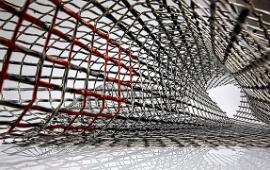Swinburne researchers repurpose manufacturing technology to create new materials

In Summary
- This article originally featured in Swinburne's Research Impact magazine.
Swinburne researchers have repurposed a well-known manufacturing technology to create new materials for traffic sound absorption, superlenses and earthquake proofing.
It’s already fairly common in manufacturing to simulate the incremental removal of superfluous material from a model to optimise lightweight and material-efficient design. This software-based approach is called Bidirectional Evolutionary Structural Optimisation (BESO), and is being used in the design of everything from bridges to car doors.
It can also be used to design materials unlike any seen before on Earth, according to Professor Xiaodong Huang from Swinburne’s Department of Mechanical Engineering and Product Design Engineering.
“The generalised BESO method, called ‘topological optimisation’, can be used to determine the spatial distribution of materials needed to achieve the best performance while satisfying multiple objectives and constraints,” explained Huang.
“It is an important tool in civil, aerospace, mechanical and automotive engineering, all of which demand lightweight, low-cost, high-performance structures. But, by integrating physics, the method also has great potential in other design problems.”
Multi-discipline, multi-physics topological optimisation has become a hot topic in academia and industry, because of its potential to help engineer microstructural materials or ‘metamaterials’ so they have new and sometimes incredible properties.
By controlling electromagnetic, acoustic and mechanical waves, these materials could help find solutions for everything from perfect vibration and energy absorption to light bending for invisibility cloaking.
The method has brought Huang’s team a string of leading research outcomes in recent years. In 2017, they co-authored a paper on the design of a 3D acoustic metamaterial that blocks low frequencies for sound cloaking in spaces such as road tunnels.
Another material from a 2017 paper used light to create the properties of a superlens — lenses that take microscopes beyond the natural diffraction limit, a constraint that limits the resolution fineness of conventional lenses.
In 2018, the team also developed an algorithm to optimise understandings of damping and the natural resonant frequency of macrostructures to improve earthquake resistance through the design of the microstructure of building materials.
Each finding is aimed at specific industrial applications, and Huang said, once commercialised, metamaterials such as theirs “are expected to usher in a new era of engineering.”

